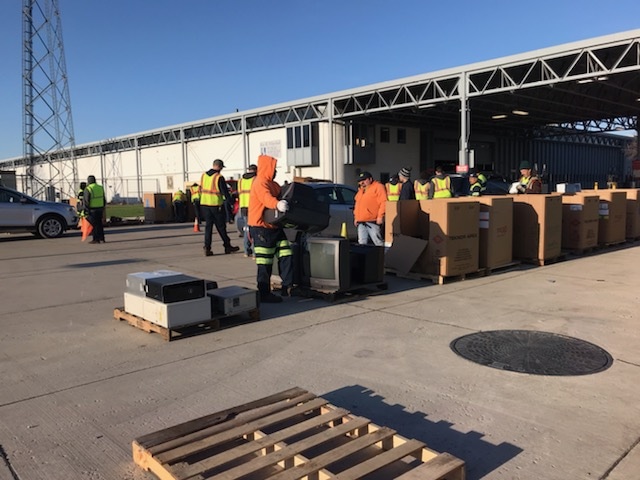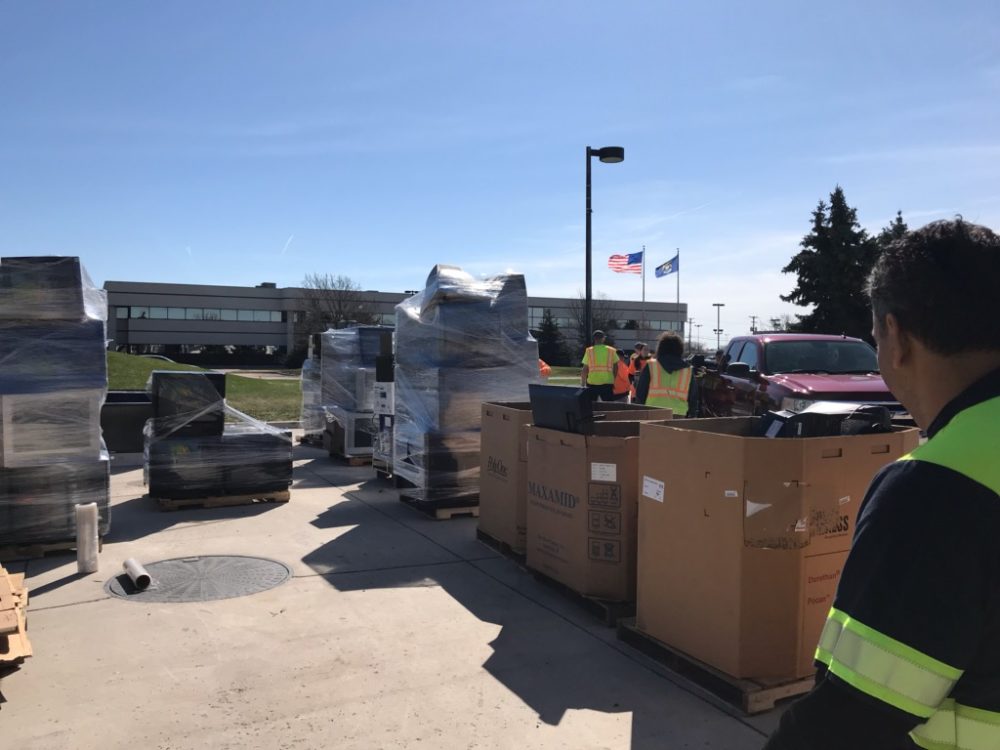Table of Contents
Why is it important to recycle e-waste?
Is it illegal to throw away electronics?
How to properly recycle electronics
Data Liability and security
How to Prepare your Business Electronics for Recycling
What is e-waste? And how do we dispose of it?
E-waste is electronic products that are unwanted, not working, and nearing or at the end of their “useful life.” Computers, televisions, VCRs, stereos, copiers, and fax machines are everyday electronic products.
The ongoing challenge of how best to dispose of used and unwanted electronics isn’t a new one and dates back at least to the 1970s. But a lot has changed since then, particularly the number of electronics being discarded today.
We also have something else today: a term for this issue. After several terms got suggested, including “Digital rubbish,” a consensus formed around the simple word “e-waste.”
E-waste Defined
E-waste is any electrical or electronic equipment that’s been discarded. This includes working and broken items that are thrown in the garbage or donated to a charity reseller like Goodwill. Often, if the item goes unsold in the store, it will be thrown away. E-waste is particularly dangerous due to toxic chemicals that naturally leach from the metals inside when buried.

List of Common E-waste Items:
Home Appliances
- Microwaves
- Home Entertainment Devices
- Electric cookers
- Heaters
- Fans
Communications and Information Technology Devices
- Cell phones
- Smartphones
- Desktop Computers
- Computer Monitors
- Laptops
- Circuit boards
- Hard Drives
Home Entertainment Devices
- DVDs
- Blu Ray Players
- Stereos
- Televisions
- Video Game Systems
- Fax machines
- Copiers
- Printers
Electronic Utilities
- Massage Chairs
- Heating Pads
- Remote Controls
- Television Remotes
- Electrical Cords
- Lamps
- Smart Lights
- Night Lights
- Treadmills
- FitBits
- Smart Watches
- Heart Monitors
- Diabetic Testing Equipment
Office and Medical Equipment
- Copiers/Printers
- IT Server Racks
- IT Servers
- Cords and Cables
- WiFi Dongles
- Dialysis Machines
- Imaging Equipment
- Phone & PBX systems
- Audio & Video Equipment
- Network Hardware (i.e. servers, switches, hubs, etc.)
- Power Strips & Power Supplies
Uninterrupted Power Supplies (UPS Systems) - Power Distribution Systems (PDU’s)
- Autoclave
- Defibrillator
Leftover ‘New’ Technology
Today, though, a growing amount of e-waste is not considered to be products that have stopped working or become obsolete.
Technological advances are coming at us at such a dizzying speed that a lot of electronic devices that still work fine are the ones considered obsolete.
Think of the many VCR players that got replaced when the DVD player hit the market, and now the DVD players getting replaced by Blu-ray players. If a product is powered electronically and someone thinks they can create a better version, that contributes to e-waste.
And we care about this because, for years now, unwanted electronic devices have been filling landfills across the globe. In the U.S. alone, the Environmental Protection Agency estimates that up to 60 million metric tons of e-waste end up in landfills every year.
E-waste Hides Toxic Materials
While above ground, modern electronics are safe to use and be around. However, most electronics contain some form of toxic materials, including beryllium, cadmium, mercury, and lead, which pose serious environmental risks to our soil, water, air, and wildlife.
When E-waste gets buried at a landfill, it can dissolve in microscopic traces into the gross sludge that permeates at the landfill. Eventually, these traces of toxic materials pool into the ground below the landfill. This is known as leaching.
The more E-waste and metals at the landfill, the more of these trace toxic materials show up in the groundwater.
Leeching Poisons Nearby Water
The problem is that there is so, so much E-waste that the trace amounts have ballooned over the years. That toxic water under the landfill doesn’t stop below the landfill. It continues to the groundwater and the sources to all the freshwater in the surrounding area.
Not only is this bad for anyone using a natural well, but it hurts the nearby wildlife. That, in turn, causes the wildlife to get sick from lead, arsenic, cadmium, and other metal poisonings due to the high concentration of these minerals.
Mining For New Metals Causes This Too
Not only is this a problem for E-waste in landfills, but this is a side effect of mining for new sources of metal too.
Having an environmentally-friendly source of recycled metal is better for the environment than a company digging up new sources of ore. Every time you recycle your electronics, you are preventing your E-waste from leaching toxic metals into your groundwater. But you’re also preventing it from happing at a mine somewhere else.
How You Can Help
Fortunately, there’s a proven solution. The recycling of e-waste serves a lot of useful purposes. For instance, include protecting human and environmental health by keeping those devices out of landfills. Or recovering the parts within the devices that still have value, and providing manufacturers with recycled metals that can be used to make new products.
Virtually all electronic waste contains some form of recyclable material. That includes materials like plastic, glass, and metals, which is why they may be considered “junk” or “obsolete” to consumers but still serve an essential purpose. It’s ironic, in some ways, that these devices are called “e-waste,” since they’re not waste at all. But in far too many instances, they are thrown away.
With electronic recyclers like GLEC, we have a solution. The challenge is getting recycling rates, still stubbornly low, to increase.
E-waste Problems
The definition of e-waste is likely to keep expanding. In an era of rapid technological advancement, more and more highly sophisticated electronic goods are being invented and manufactured. Just think of the concept of the “smart home.” It’s easy to recognize how many electronic devices can now do everything from offer security to turning lights on and off, to having fresh coffee ready before we wake up.
Unfortunately, a skyrocketing amount of e-waste is being written off by owners as junk. There’s no more significant example of that than computers, laptops, and smartphones.
New models arrive even as the current one appears to be working just fine. Despite that, the latest version always provides additional features that make it seem too enticing to resist.
So in answer to the question, “What is e-waste?” a good response today might be, “It depends.”
The technology innovators continue to create electric devices designed to make our lives easier and more convenient in every conceivable way. Still, we seem all too susceptible to quickly pitching the machines we already have. It doesn’t matter how satisfied we’ve been with them up until now.
How Did We Get to This Point?

In 1976, Congress first addressed the issue of hazardous waste disposal with the passage of the Resource Conservation and Recovery Act. This act sets standards for protecting human health and the natural environment from the potential hazards of waste disposal.
One of the goals of the law was to ensure the management of waste in an environmentally sound manner.
The next major step was the Basel Convention in March 1989, an international treaty designed to reduce the movements of hazardous waste between nations and prevent the transfer of hazardous waste from developed to less-developed countries.
One thing that’s grown significantly since then has been the e-waste recycling industry. This industry has the most proven way of keeping e-waste out of landfills or from being burned in incinerators.
The recycling industry has been devoted to taking reusable parts from discarded electronic devices and recycling them for the benefit of local businesses and manufacturers.
As the amount of e-waste keeps rising, so has this industry, which today creates hundreds of thousands of jobs across the world by recycling the electronics we no longer want.
So much of what’s in e-waste still has value. Circuit boards contain valuable metals like silver, tin, gold, palladium, and copper.
Hard drives can be shredded and processed into aluminum ingots for use in the automotive industry.
In 1991, the first electronic waste recycling system was implemented in Switzerland with the introduction of a system to collect refrigerators. Other electric and electronic devices got added to the system in later years.
A decade later, the European Union implemented a similar system called the Waste Electrical and Electronic Equipment Directive to establish e-waste recycling requirements for member nations.
In the U.S., there are no federal laws governing e-waste, although 25 states have their own e-waste rules.
Is “e-waste” clearly defined?
The term “e-waste” usually applies to consumer and business electronic equipment that’s no longer wanted, but that contains material that renders them hazardous when placed in landfills.
But we know that every year, the list of e-waste items gets longer – and longer. In January, when the Consumer Electronics Show opened in Las Vegas, there was a steady stream of new product announcements, like the one by Audio Technica. A Japanese company that unveiled two new wood-based, belt-drive turntables, the AT-LPW40TN, and AT-LPW30TK, created to deliver high-fidelity audio performances.
At the same show, TCL Communication debuted a brand new Alcatel smartphone with a Full View Display.
Other new devices on the market today include FXD, which can instantly diagnose car problems when your “Check Engine Light” comes on. Or, the KeySmart Pro, which is an organizer providing a better way to organize and carry your keys. And HeatBuddy, an energy-efficient plug-in heater for any room in the house, that’s small and compact.
And new ideas keep coming. And each one likely means something else that we’ve relied on in the past will become “obsolete.”
The Dangers of E-waste
According to the World Health Organization (WHO), health risks may result from direct contact with toxic materials that leach from e-waste. These include minerals such as lead, cadmium, chromium, brominated flame retardants, or polychlorinated biphenyls (PCBs). Danger can come from inhalation of the toxic fumes, as well as from the accumulation of chemicals in soil, water, and food.
This puts not just people in danger but land and sea animals as well. In developing countries, the risks are exceptionally high because some developed countries send their e-waste there. Studies have shown this global e-waste has detrimental effects on the people that work with the e-waste but also the people that live around it.
Because of this, a proper recycling process needs to be put in place to protect us and future generations.
E-waste Disposal

Since we know consumers will keep buying new devices, it’s important to keep reinforcing that message that we need to recycle the older models, not throw them out.
There are serious environmental risks if we send our electronics to a landfill. In contrast, recycling provides considerable benefits to our environment.
The solution is to turn those devices over to an experienced firm like Great Lakes Electronics Corporation, which has years of experience performing environmentally friendly recycling of electronic products.
The process is simple: gather your old and unused electronics like you would your garbage. A trash can or bin is perfect for this. For larger appliances, you usually want to gather them along with your smaller electronics in a garage. Then, bring them into Great Lakes Electronics. For consumers, the scheduled drop off day is Friday between the hours of 10 a.m. – 3 p.m. For businesses, give us a call at (586) 759-5000 to arrange pick-up service or to schedule a delivery.
Beyond The Environment – Data Security
Other than helping the environment, businesses are starting to wake up to the dangers of throwing away electronics. In an era where phishing scams are the biggest security threat for your business, most overlook their trash, putting them at risk.
How E-waste Results in Data Theft
You may have heard before that critical documents, and serial numbers need to be shredded before you throw them out. You probably know this is to stop someone from stealing your identity or signing up for a credit card with your information. Throwing out, or donating, a smartphone or laptop isn’t much different.
For both businesses and consumers, the hard drive inside your computer, or the memory stick inside your smartphone is a significant liability. All someone has to do is plug it into a new computer. There are dozens of methods of disposal, but most of them aren’t perfect. Physical destruction or dismantling of your electronics is the only sure-fire way to get it done. However, it should be done by a professional–modern laptop and smartphone batteries can explode if heavily damaged or dismantled incorrectly.
So why is this important for a business?
Businesses can be held liable for the security of their clients and employee’s data being misused or stolen. Throwing out or donating your old business electronics can be a legal liability because of it.
Great Lakes Electronics Corporation – E-waste Recyclers
The team at Great Lakes Electronics Corporation will disassemble these items into parts, and the ones that still have value can be sold for reuse. Other parts are used for metals recovery. Everything within your devices gets recycled. To learn more, contact Great Lakes Electronics Corporation at 888-392-7831 today.

